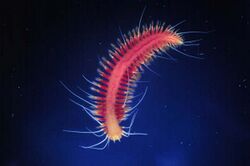Biology:Hesiocaeca methanicola
From HandWiki
| Hesiocaeca methanicola | |
|---|---|

| |
| H. methanicola | |

| |
| Close up of the head of H. methanicola | |
| Scientific classification | |
| Kingdom: | |
| Phylum: | |
| Class: | |
| Order: | |
| Family: | |
| Genus: | Hesiocaeca
|
| Species: | H. methanicola
|
| Binomial name | |
| Hesiocaeca methanicola Desbruyères & Toulmond, 1998
| |
Hesiocaeca methanicola is a species of polychaete worm that inhabits methane clathrate deposits in the ocean floor. The worms colonize the methane ice and appear to survive by gleaning bacteria which in turn metabolize the clathrate.
In 1997, Charles Fisher, professor of biology at Pennsylvania State University, discovered the worm living on mounds of methane ice at a depth of half a mile (~800 m) on the ocean floor in the Gulf of Mexico.[1] Fisher reported that experiments with live specimens showed that mature worms could survive in an anoxic environment for up to 96 hours. The experiments also showed that the larvae were dispersed by currents, and died after 20 days if they did not find a place to feed.
References
- ↑ C. R. Fisher; I.'R. MacDonald; R. Sassen; C. M. Young; S. A. Macko; S. Hourdez; R. S. Carney; S. Joye et al. (2000). "Methane ice worms: Hesiocaeca methanicola colonizing fossil fuel reserves". Naturwissenschaften 87 (4): 184–187. doi:10.1007/s001140050700. PMID 10840806. Archived from the original on 2006-02-20. https://web.archive.org/web/20060220001902/http://www.sb-roscoff.fr/Ecophy/PDF/00-Fisher-NatWis.pdf.
External links
- Dane Konop (July 29, 1997). "Scientists discover methane ice worms on Gulf of Mexico sea floor". National Oceanic and Atmospheric Administration. http://www.publicaffairs.noaa.gov/pr97/jul97/noaa97-44.html.
- David Pacchioli (May 4, 2001). "Redefining "Life as We Know it"". SpaceRef.com. http://www.spaceref.com/news/viewnews.html?id=339.
Wikidata ☰ Q150296 entry

